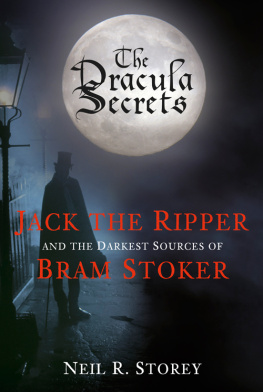J ACK THE R IPPER

J ACK THE R IPPER

THE DEFINITIVE HISTORY
P AUL B EGG

First published 2003 by Pearson Education Limited
This revised (paperback) edition published 2005
Published 2013 by Routledge
2 Park Square, Milton Park, Abingdon, Oxon OX14 4RN
711 Third Avenue, New York, NY 10017, USA
Routledge is an imprint of the Taylor & Francis Group, an informa business
Copyright 2005, Taylor & Francis.
The right of Paul Begg to be identified as author of this work has been asserted by him in accordance with the Copyright, Designs and Patents Act 1988.
All rights reserved. No part of this book may be reprinted or reproduced or utilised in any form or by any electronic, mechanical, or other means, now known or hereafter invented, including photocopying and recording, or in any information storage or retrieval system, without permission in writing from the publishers.
Notices
Knowledge and best practice in this field are constantly changing. As new research and experience broaden our understanding, changes in research methods, professional practices, or medical treatment may become necessary.
Practitioners and researchers must always rely on their own experience and knowledge in evaluating and using any information, methods, compounds, or experiments described herein. In using such information or methods they should be mindful of their own safety and the safety of others, including parties for whom they have a professional responsibility.
To the fullest extent of the law, neither the Publisher nor the authors, contributors, or editors, assume any liability for any injury and/or damage to persons or property as a matter of products liability, negligence or otherwise, or from any use or operation of any methods, products, instructions, or ideas contained in the material herein.
ISBN: 978-1-405-80712-8 (pbk)
British Library Cataloguing in Publication Data
A CIP catalogue record for this book can be obtained from the British Library
Library of Congress Cataloging-in-Publication Data
Begg, Paul
Jack the Ripper: the definitive history/Paul Begg.1st ed. p. cm. Includes bibliographical references and index. ISBN 1-4058-0712-1 (pb) 1. Jack, the Ripper. 2. Serial murdersEnglandLondonHistory19th century. 3. Whitechapel (London, England)History. I. Title. HV6535.G6L6183 2005 364.1523092dc22 2004048915
for
Martin Fido and Keith Skinner
in the sincere hope that they will find some merit in this
effort to set the crimes in their historical context

Acknowledgements

There are many people who have, over the years, assisted with my research into the Jack the Ripper mystery and many have become good and very valued friends. Not only would it be impossible to thank them all, but I am sure I would unintentionally insult someone to whom I owe a great debt by omitting their name. I will do no one a disservice, however, if I express my sincerest gratitude to my wife Judy and daughter Siobn, whose support and encouragement is and has been unstinting and is deeply and genuinely appreciated. My thanks, of course, also go to Josh.
The publishers are grateful to the following for permission to reproduce copyright material: Royal London Hospital Archives for Contemporary drawing of Mitre Square, Royal London Hospital Archives; The National Archives of England, Wales and the United Kingdom for Catharine Eddowes alias Beddowes (29 Sept. 1888): photograph of the deceased, and Mary Jane Kelly, as found in Millers Court.
In some instances we have been unable to trace the owners of copyright material, and we would appreciate any information that would enable us to do so.
CONTENTS


Why does Jack the Ripper exert such fascination?
The quick and easy answer is that the mystery of his identity taunts the curiosity and inspires the imagination of the armchair detective. But such a simple answer, although true, dodges the question. There are lots of unsolved crimes, but none has the allure of Jack the Ripper. Being unsolved doesnt explain the continuing fascination with the case. The horrific brutality of the murders is even less of an answer. It is difficult to imagine how a murderer could be more brutal than Jack the Ripper, yet recent history has produced killers whose sickening depravity has far exceeded the Rippers post-mortem mutilations so the shock and horror of the crimes dont explain Jack the Rippers notoriety either. As Jack the Ripper observes in Nicholas Mayers 1979 movie, Time After Time, Ninety years ago I was a freak. Now Im an amateur.
It should also be observed that the Great Victorian Mystery, as the Jack the Ripper murders have been dubbed, hasnt always received the profound interest and detailed study it does today. The bookshelf of an enthusiast of the Ripper mystery could easily contain over eighty non-fiction books, almost all of them propounding a theory about the killers identity, but more and more of them being highly factual reference titles. What would be noticeable, though, is that nearly every one has been published since 1960. The question about Jack the Rippers appeal would therefore seem to have not only to do with what happened way back then but also to do with what happened in or about 1960 to ignite a mini-publishing boom that has lasted for forty years and shows no sign of dying out.
In late 1959 the pioneering television journalist and broadcaster Daniel Farson For the first time it seemed possible that the mysterious Jack the Ripper might be given a face and interest in the mystery began to increase.
Interest was heightened on the publication of an article by Dr. Thomas Eldon Stowell, Jack the Ripper A Solution? in The Criminologist in November 1970. Stowell maintained that he had seen in the papers of Sir William Gull that Jack the Ripper was Prince Albert Victor,
But of course the Ripper was remembered before 1960. He was remembered differently though. For reasons which in essence are the raison dtre of this book, very soon after the murders stopped and probably even as they were being committed Jack the Ripper passed through a strange transformation from real life murderer to bugaboo of nightmare. It is said that mothers warned their children to be good or Jack the Ripper will get you!. Jack the Ripper became the ultimate representation of human evil, a lurker in the shadows, the personification of the feared and unknown. The image is reflected in numerous stories going back to Frank Wedekinds turn of the century Lulu , in which the predatory Lulu ends up a victim of the predator Jack the Ripper. References can also be found in diverse offerings like Sands of Iwo Jima (1949), a movie about the successful American campaign in 1945 to capture the small island of Iwo Jima, 660 miles south of Tokyo. In one scene near the beginning of the movie two soldiers are complaining about the bullying Marine Sergeant John Stryker (John Wayne). In mitigation one soldier says, But at least he knows his job. Unimpressed, the other soldier replies, So did Jack the Ripper. It isnt a great moment of cinema history, but it illustrates how Jack the Ripper had passed into the common language as an icon of evil. It wasnt necessary to say who Jack the Ripper was, what he did, or when he did it. People didnt have to know even that Jack the Ripper really existed. People understood because they knew what Jack the Ripper represented. The question, however, is why? Why did Jack the Ripper develop this almost mythic status? What distinguished Jack the Ripper from other murderers of the day?
Next page















